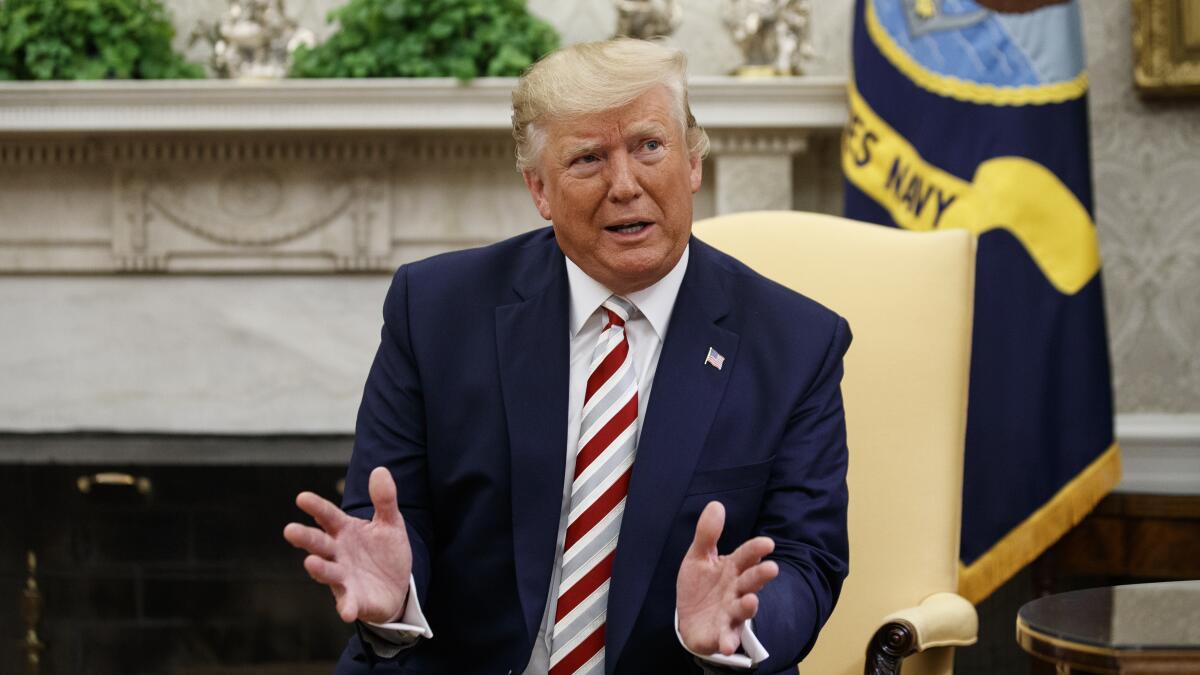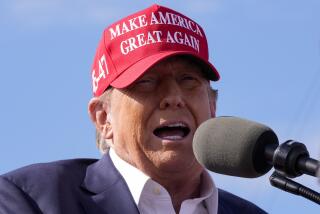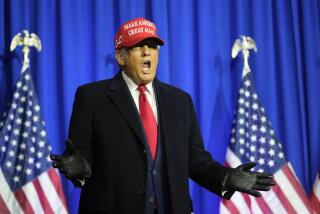Editorial: There’s a right response to recession fears — and then there’s Trump’s

President Trump confirmed Tuesday that he has been thinking about cutting payroll taxes, which is not a terrible way to counter a recession. But he delivered the message in quintessentially Trumpian fashion, mixing one defensible idea in with a number of indefensible ones and muddying the waters about what he’s trying to accomplish.
Some worrisome signs have emerged recently about the U.S. economy, with businesses cutting their investments and investors shifting money into safer bets, like long-term Treasury notes. But there are positive signs as well, most notably strong consumer spending and sky-high consumer confidence, steady job growth and exceptionally low unemployment.
What do all these indicators mean? No one knows for sure, but UCLA’s Anderson School of Management offers a forecast that’s widely shared: The U.S. economy is likely to keep growing through 2020, just more slowly as the effects of the 2017 tax cut wear off and the costs of Trump’s trade policies add up.
Naturally, that’s not what Trump or his advisors have been saying in the days since long-term Treasury bond rates fell below short-term bond rates — a frequent sign of a looming recession. “Our economy’s incredible,” Trump told reporters at the White House Tuesday. The only people talking about a recession, Trump added, are his political opponents and the media, who, he said, would love to see one.
That’s a ridiculous assertion, but it’s just as bad to pretend there’s no risk of a downturn as it is to exaggerate the possibility. What Trump ought to be doing is coming up with a contingency plan in case the signs of a recession get clearer. Instead, he’s just kept calling for Washington to step on the economic gas pedal, as he’s been doing since the day he was inaugurated — regardless of how well the country was doing at the time.
As he put it Tuesday, “We’re looking at various tax reductions, but I’m looking at that all the time anyway, tax reductions. That’s one of the reasons we’re in such a strong economic position.”
With the federal budget projected to post trillion-dollar deficits for the rest of Trump’s term, tax cuts should be off the table unless there’s a pressing need for stimulus. So by denying the signs of weakness in the economy, the president is effectively declaring that there’s no need for a tax cut.
If there were a need to boost the consumer spending that drives the U.S. economy, temporarily cutting the payroll tax would be one of the better ways to do it. The tax hits low- and moderate-income workers the hardest, and they’re more likely to spend the money than save it (although research shows that they’re even more likely to pay off debts, reducing the tax cut’s stimulative effect) . But because consumer spending remains strong, another tax cut may not provide much of a spark at this point. It also could drain funds out of Social Security, which is already paying out more in benefits than it’s collecting in payroll taxes.
In addition to floating the idea of a payroll tax cut, Trump also talked about lightening the burden of the (already reduced) capital gains tax by factoring in inflation, which would reduce the amount of any long-term gains. As we’ve said before, that’s a terrible idea, delivering little discernible benefit to the economy while enriching the highest-income Americans. Trump also berated the Federal Reserve for not trying to goose the economy by printing money and reducing short-term interest rates sharply, as if the central bank existed to serve his short-term political needs instead of the country’s long-term interests. If the Fed uses all its firepower while the economy is still growing, it will have little leverage left when an actual recession strikes.
The best thing the president could be doing to help the economy now would be to lift the global tariffs on steel and aluminum and the billions of dollars of levies on Chinese imports, all of which act like a tax on American consumers and manufacturers. His spats with U.S. trading partners have also cast a pall over global trade, contributing to the slowdowns around the world that, in turn, are harming U.S. exporters. Short of that, Trump should work with Congress to bring to fruition the $2-trillion infrastructure deal he struck with top Democrats. With borrowing costs at rock bottom and U.S. roads, bridges and transit systems badly in need of investment, Washington should be spending that money regardless of the clouds on the horizon.
More to Read
A cure for the common opinion
Get thought-provoking perspectives with our weekly newsletter.
You may occasionally receive promotional content from the Los Angeles Times.






